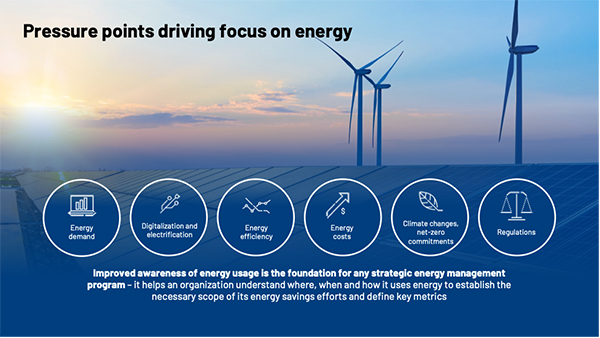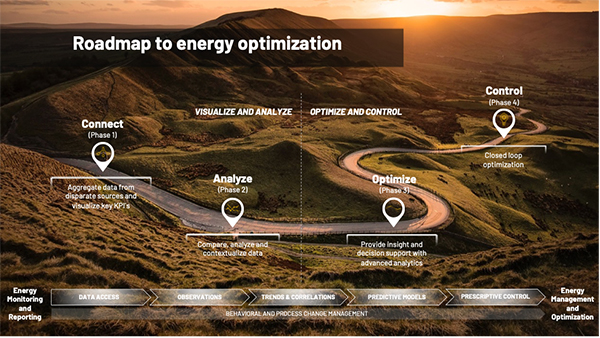With emphasis on energy management, DataOps have a crucial role in identifying areas for savings and achieving sustainability goals.
By Oliver Haya, Business Manager, Rockwell Automation
For countries to businesses and right down to individuals, tackling climate change is now a major focus. Rising energy costs and demand, the digitalization of energy networks, the need to optimize efficiency, and increasing regulations are pressure points driving greater emphasis on energy management.

Across manufacturing, energy is one of the fastest-growing production costs, pushing the need to improve efficiency. With worldwide power consumption predicted to increase by 300% by 2050, a stable well-managed energy supply will be key to optimizing critical functions. As manufacturers drive towards “net zero,” that is, balancing the amount of greenhouse gas (GHG) produced and the amount removed from the atmosphere, energy management has become a key operational factor.
Improved awareness of energy usage is the foundation for any strategic energy management program. For manufacturers seeking to reduce energy costs, improve their sustainability footprint and position themselves to meet the demands of a changing regulatory environment, a solid energy management program helps them to understand where, when and how they use energy. This, in turn, enables them to establish the necessary scope of energy savings efforts and define key metrics.
Historically, gathering energy data presented challenges due to the distributed and siloed nature of networks and data sources. This lack of connectivity limited an organization’s ability to pull energy performance metrics from specific industrial equipment as the data in question lacked OT (Operational Technology) context. For example, important details include production runs, quantity and types of goods produced, and types of energy used for each asset. Without OT context, it’s very common for manufacturers to get only a monthly report of the entire usage of a site.
A comprehensive energy management strategy requires a holistic view of energy consumption that involves looking at energy usage from five sources, known as WAGES (water, air, gas, electricity and steam). Each of these elements has a different carbon footprint and different costs, so it’s important to first identify GHG emission sources, which involves dividing them into three categories:
Companies must cut emissions across all three scopes to meet internationally agreed-upon targets related to sustainability. Creating a benchmark of existing energy consumption is key: assessing the current carbon impact, extrapolating where less carbon can be emitted and what the energy impacts of that will be. In tandem, a significant challenge that manufacturers face is that they usually receive a monthly roll-up of a utility bill and then must sort which products are generating which parts of that energy consumption. So, if they want to look at whether it’s more energy-intensive to produce product A or product B, they cannot derive that data unless they make a month of product A and a month of product B. However, manufacturing doesn’t work like that, commonly having multiple product lines running simultaneously. To solve this, it’s necessary to dig into data in a more granular fashion by looking at individual devices such as flow meters, electrical meters, power monitors and intelligent connected devices that generate information about water, air, gas, electricity and steam, so manufacturers can integrate that data.
Collecting data from individual devices across a network isn’t enough, however. Now the data must be contextualized in the wider concept of the manufacturing plant. For example, which meters measured energy use for which products and which products were being produced at what time? What happens where products are lost, due to quality or operational issues? This presents a different challenge.
Of course, data is only as valuable as the analytics behind it, so a comprehensive energy management strategy requires connecting and integrating disparate sources so that the correct data can be collected, analyzed, contextualized and leveraged by manufacturers. Introducing industrial DataOps focuses on breaking down silos and optimizing the broad availability and usability of industrial data to drive operational improvement.
Complex industrial data requires context if it is to be used broadly in an organization. Industrial DataOps can provide a central, contextualized source of truth with automated data pipelines offering industrial users a common and simplified way to discover, understand and analyze industrial data. This contextualization is vital as it not only uncovers and identifies relationships between elements of data are connected, but also where the relationships are not explicitly represented. So, whereas manufacturers might previously have only collected information at the enterprise or site level, the convergence of data and analytics with industrial operations within industrial DataOps enables data to be parsed at a more granular or product level. Consider a specific product like wheat crackers. Manufacturers can examine production data and contextualize that to find the energy consumed to produce a batch of, say, 100,000 boxes. Imagine 1,000 boxes were lost due to quality or because of operations issues. With the level of detail now available, the manufacturer can derive not only the cost of energy for the overall batch, but also the lost product.
This insight is achieved by leveraging existing data connections and asset-centric data relationships from OT and IT data sources. These feed into a production data platform providing industrial DataOps capabilities to add value to data, which in turn enable industry solutions, including energy management, batch operations, asset intelligence and custom applications. With the data platform at is core, new applications can be built and scaled rapidly, speeding time-to-value.
To classify factors such as energy intensity – how much energy went into this batch of those wheat crackers on this day – all kinds of information is required relating to the raw materials used, the production data, what recipe was used, what the quality information was, and what the energy source was. Industrial DataOps’ contextualization enables manufacturers to gather and dissect all of that data methodically to establish WAGES usage. It’s possible to take this analysis a step further and understand, for example, when that electricity was used, how much of that came from solar, how much of that came from wind, how much of that came from natural gas, and so on.
Having this verified information enables manufacturers to provide energy provenance and put a stamp on a product that says, “this product consumed X kilograms of carbon dioxide as part of its production.” This is becoming a closer reality from a regulatory perspective where Scope 1 and Scope 2 emissions of products are soon to be required in the European Union.
An additional area of opportunity lies in looking at other factors that can influence the cost of production for energy management, beyond knowing how much WAGES usage went into manufacturing. The depth of data available through correctly optimized industrial DataOps can look at any number of elements, for example:
The work put into data contextualization to make energy management realistic can also be used to improve assets, like batch analytics. In the food and beverage industry, a consideration relating to batch analytics might be whether it makes sense to run at a lower temperature for a little bit longer because that will have a lower overall energy consumption than running at a higher temperature for a shorter period without sacrificing quality or asset utilization. In industries such as mining, metals and cement, which are incredibly energy intensive, making even a small difference through asset improvement analytics using industrial DataOps can make a big impact in terms of revenue and capex.
The route to energy optimization is not linear. There are no short-cuts in the journey from energy monitoring and reporting to energy management and optimization. Manufacturers can’t simply jump to autonomous control of their energy consumption. Figure 1 below shows the roadmap to energy optimization as a four-phased journey divided into two over-arching elements: Visualize and Analyze and Optimize and Control.
Connecting to data access and aggregating data from various sources and framing key performance indicators is the first phase. Through observation, data is then compared, analyzed and contextualized in phase two, with trends and correlations starting to emerge, which feed into phase three to create predictive models, increasingly driven by artificial intelligence (AI) based on the optimized insight and decision support that advanced analytics provides.

Finally, phase four implements prescriptive control through closed loop optimization. At this stage, industrial DataOps enables a system running trained to understand variables, along with rules and guidelines to effectively manage those variables and automate itself to react to them with specific actions.
An industrial energy management solution built on an industrial DataOps platform leverages understanding and optimize energy usage with contextualized analytics to enables manufacturers to reduce energy costs by understanding energy usage and identify areas for savings and achieve sustainability goals by increasing efficiency and achieving regulatory compliance.

Oliver Haya is a Business Manager for Data, Hub, and Application Platforms. With over 15 years working with automation customers across industries, Oliver has developed a deep appreciation for the opportunity that better data utilization offers manufacturers. In his current role, he has responsibility for making data available and meaningful to users and applications that can drive business value from that data.
In this episode, I sat down with Beejan Giga, Director | Partner and Caleb Emerson, Senior Results Manager at Carpedia International. We discussed the insights behind their recent Industry Today article, “Thinking Three Moves Ahead” and together we explored how manufacturers can plan more strategically, align with their suppliers, and build the operational discipline needed to support intentional, sustainable growth. It was a conversation packed with practical perspectives on navigating a fast-changing industry landscape.